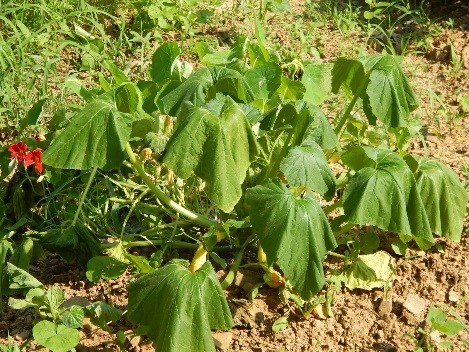Telling when a melon is ready to be harvested can be a challenge, or it may be quite easy. It all depends on the type of melon.
 Let’s start with the easy one. Muskmelons are one of those crops that tell you when they are ready to be picked. This can help you not only harvest melons at the correct time but also choose good melons when shopping.
Let’s start with the easy one. Muskmelons are one of those crops that tell you when they are ready to be picked. This can help you not only harvest melons at the correct time but also choose good melons when shopping.
As a melon ripens, a layer of cells around the stem softens so the melon detaches easily from the vine. This is called “slipping” and will leave a dish shaped scar at the point of stem attachment. When harvesting melons, put a little pressure where the vine attaches to the fruit. If ripe, it will release or “slip.”
 When choosing a melon from those that have already been harvested, look for a clean, dish shaped scar. Also, ripe melons have a pleasant, musky aroma if the melons are at room temperature (not refrigerated).
When choosing a melon from those that have already been harvested, look for a clean, dish shaped scar. Also, ripe melons have a pleasant, musky aroma if the melons are at room temperature (not refrigerated).
Watermelons can be more difficult and growers often use several techniques to tell when to harvest.
- Look for the tendril that attaches at the same point as the melon to dry and turn brown. On some varieties this will need to be completely dried before the watermelon is ripe. On others it will only need to be in the process of turning brown.
- The surface of a ripening melon develops a surface roughness (sometimes called “sugar bumps”) near the base of the fruit.
- Ripe watermelons normally develop a yellow color on the “ground spot” when ripe. This is the area of the melon that contacts the ground.
By: Cassie Homan

 Is your garden struggling to do well in this hot, dry weather we have had lately? Extended periods of high temperatures, like the 100 degree weeks we have seen, can really take a toll on our gardens. The most important thing you can do is keep everything watered, you don’t want your plants heat and water stressed. Tomatoes tend to be one of the pickiest vegetables, and even stop producing fruit, because of lack of pollination, when night temperature remain above 75 degrees.
Is your garden struggling to do well in this hot, dry weather we have had lately? Extended periods of high temperatures, like the 100 degree weeks we have seen, can really take a toll on our gardens. The most important thing you can do is keep everything watered, you don’t want your plants heat and water stressed. Tomatoes tend to be one of the pickiest vegetables, and even stop producing fruit, because of lack of pollination, when night temperature remain above 75 degrees.